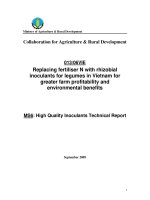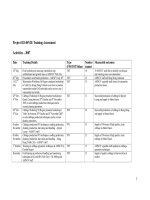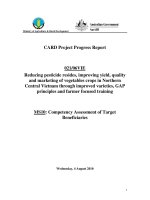Báo cáo khoa học nông nghiệp " Processing, Preservation and Wood from Plantations " pot
Bạn đang xem bản rút gọn của tài liệu. Xem và tải ngay bản đầy đủ của tài liệu tại đây (4.51 MB, 18 trang )
Processing, Preservation and
Wood from Plantations
Philip Blackwell - University of Melbourne
&
Phạm Đức Chiến - FSIV
1
Plantations
The common species are
Acacia mangium,
Acacia auriculiformis,
Acacia hybrid,
Eucalyptus urophylla
Eucalyptus camaldulensis
Pinus ssp
Native mixed species
2
Typical plantation in Vinh Phuc Province
Plantations
Plantations need
management to obtain
the maximum return.
Pruning
Thinning
Good genetic stock
Sustainable management
can lead to FSC
certification
3
Advantages of the Australian
Species
• Fast growing
• Good return to
growers
• Grows in a range of
climatic and soil
conditions
• Easy to process
• A range of potential
markets
4
Versatile Species
Poles
Wood chips
Pulp for paper
Particle board
MDF
Saw Logs
Construction
Furniture
Veneer
Peeled
Sliced
5
Small logs
• Small logs can be
used for wood chips
or construction
timbers.
• Larger diameter logs
return higher value to
the producer.
• Straightness is also
important.
6
Problems?
• Growth Stresses
• Small diameter
• Unstable until dry
• Drying difficulties
• Difficult to preserve
• Colour variation
7
Processing
Horizontal and Vertical
Bandsaws
Cheap to purchase
Easy to use
Made in Vietnam
Reliable
8
Bandsaw
Logs are held to wooden
bearers with steel spikes.
The saw is moved over the
log to cut a board.
The board is removed
The saw is then taken back
over the log
The blade is lowered
The cutting process is
repeated
9
Sawing Patterns
Bandsaws produce flat
sawn boards.
Most boards are back
sawn (B)
Some boards in the centre
are Quarter sawn (A)
Quarter sawn boards dry
with less checking than
back sawn boards
10
B
A
Drying
• Air drying timber is Ok
for outside use
• Kiln drying is required
to make timber stable
for inside use.
• Reduces the chance
of furniture cracking
11
Product failures
12
Drying Kiln
• Combination of;
– Air flow
–Temperature
–Humidity
• Kilns require
– Monitoring
– Correct stacking
– Room for the air to
move
– Restrictions on air
movement
13
Timber Stability
• Timber will shrink
while being dried.
• Timber will change
size with changes in
moisture content
• All furniture should be
manufactured from
kiln dried timber
• Dry timber is less
susceptible to decay
14
Preservation
• Some species are
naturally durable
• Preservation is
required when timber
is to be in-ground or
out-side
• Preservation is the
process of adding
chemicals to the
timber to deter insects
or prevent decay
15
Difficulties in treating
• Many species are
difficult to treat
• In some species
sapwood is treatable.
• Sapwood is often
more susceptible to
decay
16
Future
• Higher quality logs
• Greater returns to the
growers
• Better productivity for
the sawmillers
• High value veneer
logs
• Greater percentage of
exports using
Vietnamese timber
17
Training Needs
• Training in kiln drying and kiln operations
• Training for sawmillers to understand the structure
and nature of wood and how they can process it
better.
• Training in the international requirements for timber
products in furniture manufacturing.
• Training on sawmill safety and preventive
maintenance
• Training in business management and marketing
18









